cruise control PONTIAC PONTIAC 1997 Owners Manual
[x] Cancel search | Manufacturer: PONTIAC, Model Year: 1997, Model line: PONTIAC, Model: PONTIAC PONTIAC 1997Pages: 419, PDF Size: 19.67 MB
Page 75 of 419
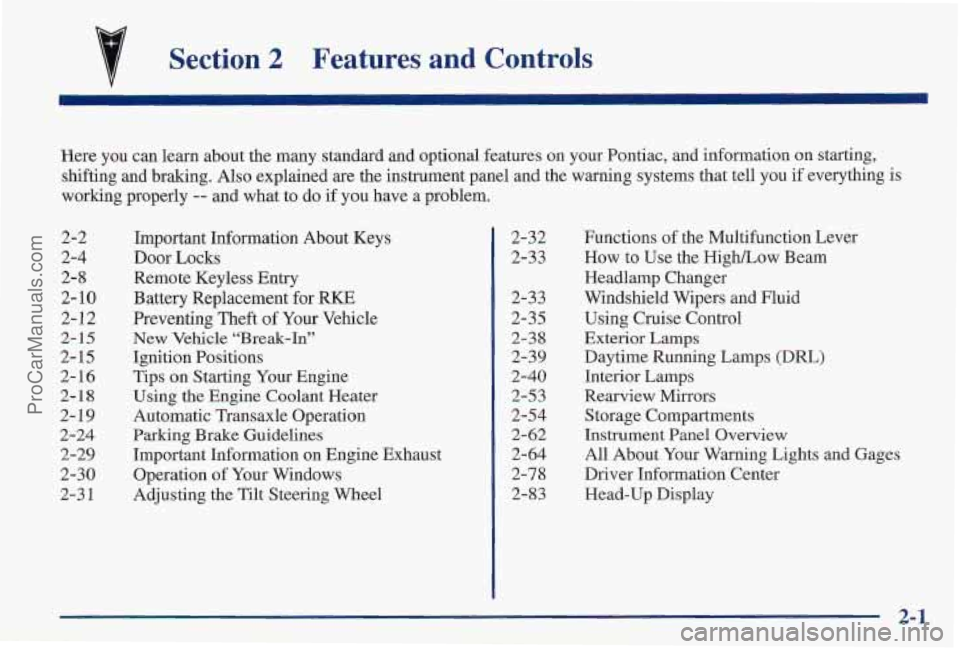
v Section 2 Features and Controls
Here you can learn about the many standard and optional features on your Pontiac, and information on starting,
shifting and braking. Also explained are the instrument panel and the warning systems that tell you if everything is
working properly
-- and what to do if you have a problem.
2-2
2-4
2-8
2- 10
2-12
2-15
2-15
2- 16
2-18
2-19
2-24
2-29
2-30
2-3 1
Important Information About Keys
Door Locks
Remote Keyless Entry Battery Replacement for RKE
Preventing Theft
of Your Vehicle
New Vehicle “Break-In”
Ignition Positions
Tips on Starting Your Engine
Using the Engine Coolant Heater
Automatic Transaxle Operation
Parking Brake Guidelines
Important Information on Engine Exhaust
Operation of Your Windows
Adjusting the Tilt Steering Wheel 2-32
2-33
2-33
2-35
2-3 8
2-39
2-40
2-5 3
2-54
2-62
2-64
2-78
2-83
Functions of the Multifunction Lever
How to Use the HighLow Beam
Headlamp Changer
Windshield Wipers and Fluid
Using Cruise Control
Exterior Lamps
Daytime Running Lamps
(DRL)
Interior Lamps
Rearview Mirrors
Storage Compartments
Instrument Panel Overview
All About Your Warning Lights and Gages
Driver Information Center
Head-Up Display
2-1
ProCarManuals.com
Page 106 of 419

Wm Signal/Multifunction Lever
1
I
Turn Signal and Lane Change Indicator
The turn signal has two upward (for right) and two
downward (for left) positions. These positions allow
you
to signal a turn or a lane change.
To signal a
turn, move the lever all the way up or down.
When
the turn is finished, the lever will return automatically.
The lever
on the left side of the steering column
includes your:
Turn Signal and Lane Change Indicator
0 Headlamp High/Low Beam
0 Windshield Wipers
Windshield Washer
Cruise Control (If Equipped)
c:
I
An arrow on the instrument
panel will flash in the
direction of the turn or
lane change.
To signal
a lane change, just raise or lower the lever
until the arrow starts to flash. Hold it there until
you
complete your lane change. The lever will return by
itself when you release it.
As you signal a turn or a lane change, if the arrow
flashes faster than normal,
a signal bulb may be burned
out and other drivers won’t see your turn signal.
2-32
ProCarManuals.com
Page 109 of 419
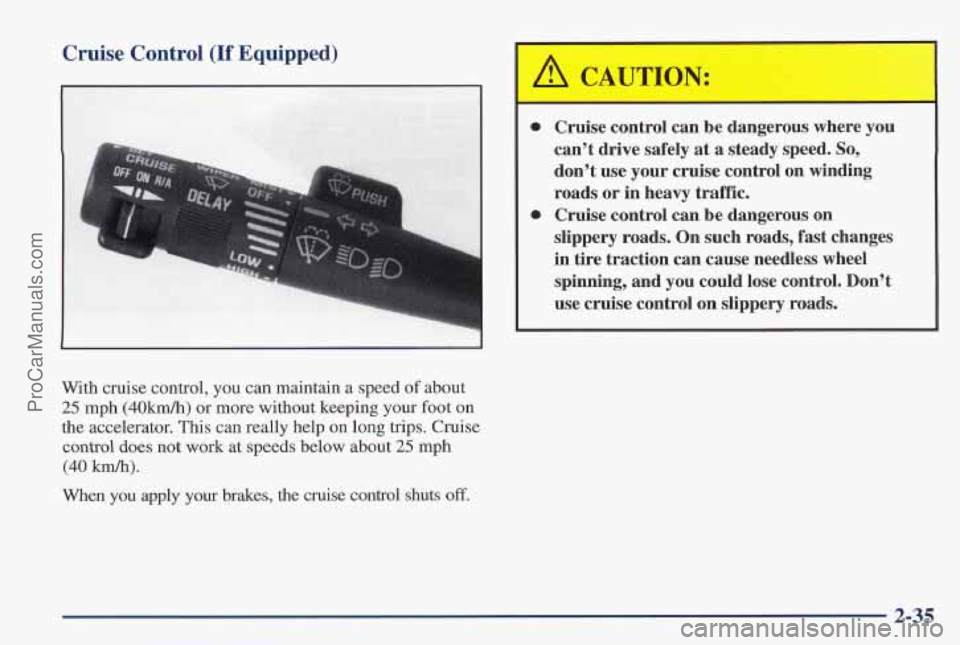
Cruise Control (If Equipped)
0
e
Cruise control can b'e dangerous where you7-'" ;: 1
can't drive safely at a steady speed. So,
don't use your cruise control on winding
roads or in heavy traffic.
Cruise control can be dangerous on
slippery roads. On such roads, fast changes
in tire traction can cause needless wheel
spinning, and you could lose control. Don't
use cruise control
on slippery roads.
With cruise control, you can maintain a speed of about
25 mph (40km/h) or more without keeping your foot on
the 'accelerator. This can really help on long
trips. Cruise
control does not
work at speeds below about 25 mph
(40 km/h).
When you apply your brakes, the cruise control shuts off.
ProCarManuals.com
Page 110 of 419
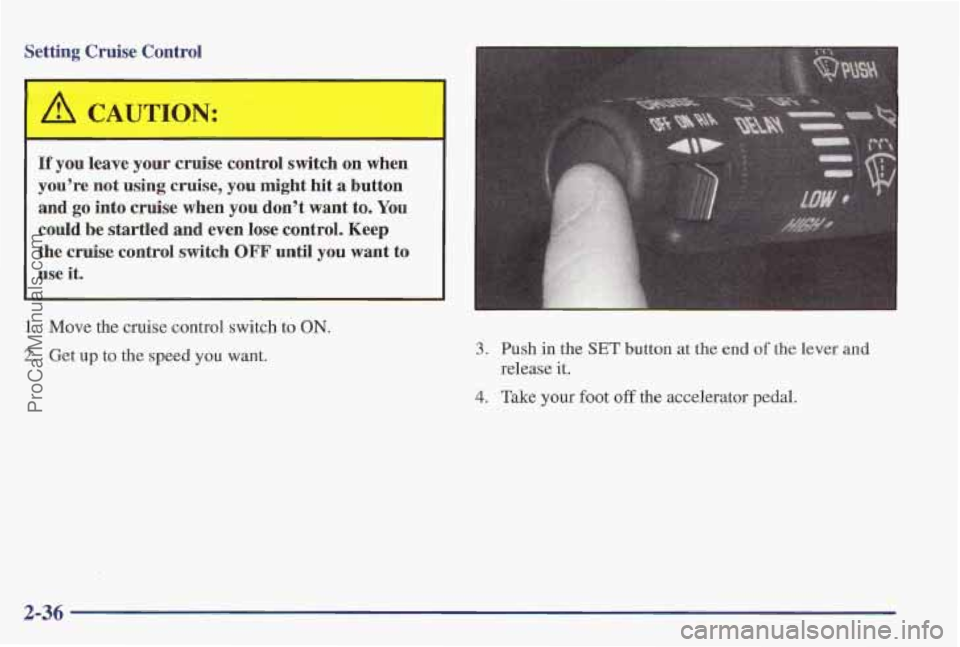
Setting Cruise Control
A CAUTION:
I
If you leave your cruise control switch on when
you're not using cruise,
you might hit a button
and
go into cruise when you don't want to. You
could be startled and even lose control. Keep
the cruise control switch
OFF until you want to
use it.
1, Move the cruise control switch to ON.
2. Get up to the speed you want. 3. Push in the SET button at the end of the lever and
release it.
4. Take your foot off the accelerator pedal.
2-36
ProCarManuals.com
Page 111 of 419

Resuming a Set Speed
Suppose you set your cruise control at a desired speed
and then you apply the brake. This,
of course, shuts off
the cruise control. But you don’t need
to reset it.
Once you’re going about
25 mph (40 km/h) or more,
you can move the cruise control switch from
ON to
R/A (Resume/Accelerate) for about half a second.
You’ll go right back up to your chosen speed and
stay
there.
Increasing Speed While Using Cruise Control
There are two ways to go to a higher speed:
Use the accelerator pedal to get to the higher speed.
Push in the SET button, then release the button
and the accelerator pedal. You’ll now cruise at the
higher speed.
Move the cruise switch from ON to R/A. Hold it there
until you get up to the speed you want, and then
release the switch. (To increase your speed in very
small amounts, move
the switch to WA for less than
half a second and then release it. Each time you do
this, your vehicle will go 1 mph (1.6 km/h) faster.)
The accelerate feature will only work after you set
the
cruise control speed by pushing the SET button.
Reducing Speed While Using Cruise Control
There are two ways to reduce your speed while using
cruise control:
Push in the SET button until you reach the lower
speed you want, then release it.
0 To slow down in very small amounts, push the SET
button €or less than half a second. Each time you do
this, you’ll
go 1 mph (1.6 km/h) slower.
2-37
ProCarManuals.com
Page 112 of 419

Passing Another Vehicle While Using Cruise Control
Use the accelerator pedal to increase your speed. When
you take your foot off the pedal,
your vehicle will slow
down to the cruise control speed
you set earlier.
Using Cruise Control on Hills
How well your cruise control will work on hills depends
upon your speed, load and the steepness of the hills.
When going up steep hills,
you may have to step on the
accelerator pedal to maintain
your speed. When going
downhill, you may have to brake or shift
to a lower gear
to keep your speed down.
Of course, applying the brake
takes you out of cruise control, Many drivers find this to
be too much trouble and don't use cruise control on
steep hills.
Ending Cruise Control
There are two ways to turn off the cruise control:
Step lightly on the brake pedal; OR
Move the cruise switch to OFF.
Erasing Cruise Speed Memory
When you turn off the cruise control or the ignition, or
shift into
PARK (P) or NEUTRAL (N), your cruise
control set speed memory is erased.
Lamps
The lamp controls are located on the lower, left side of
the instrument panel, to the left
of the steering wheel.
They control these systems:
Headlamps
@ Taillamps
Parking Lamps
License Lamps
0 Sidemarker Lamps
0 Instrument Panel Lights
0 Courtesy Lamps
0 Fo'g Lamps
2-38
ProCarManuals.com
Page 338 of 419

FUSE USAGE CHARY 1
CIRCUIT MALL PGM
WIPER
K I HSEAT/LUM 1 R DEFOG I
SEAT
CIG LTR INTLAMP STOP LAMP AUXlCNSL
CD CHG
CRUISE I/P - lCiN TURN I I I I
ABS ETSl
ABS IGN
Printed in U.S.A.
Circuit Breaker
Description
HEADLMP
Headlamps
PWR SEAT Power Seat, Power Lumbar
PWR
WBO Power Windows
Fuse Description
MALL PGM Mall Module -- Program
MALL Mall
Module
Fuse
WIPER
STR WHL ILUM
STR WHL CTRL
SUNROOF
RADIO
PWR LOCK
HSEATLUM
R DEFOG
RAP
HAZARD
PWR MIR
HVAC HI
CIG LTR
INT LAMP
STOP LP
AUXKNSL
CD CHGR
Description
Wipers
Steering Wheel Illumination
Steering Wheel Control
Sunroof
Radio, Antenna
Mall Module
-- Power Locks
Heated Seats, Power
Lumbar
Rear Defog
Retained Accessory Power,
Mall Module
Hazard Flashers
Power Mirrors
HVAC Blower -- Hi
Cigarette Lighter,
ALDL, Floor
Console Auxiliary Outlet
Mall Module-Interior lamps
Stoplamp
Auxiliary Power, Overhead Console
CD Changer
6-68
ProCarManuals.com
Page 339 of 419
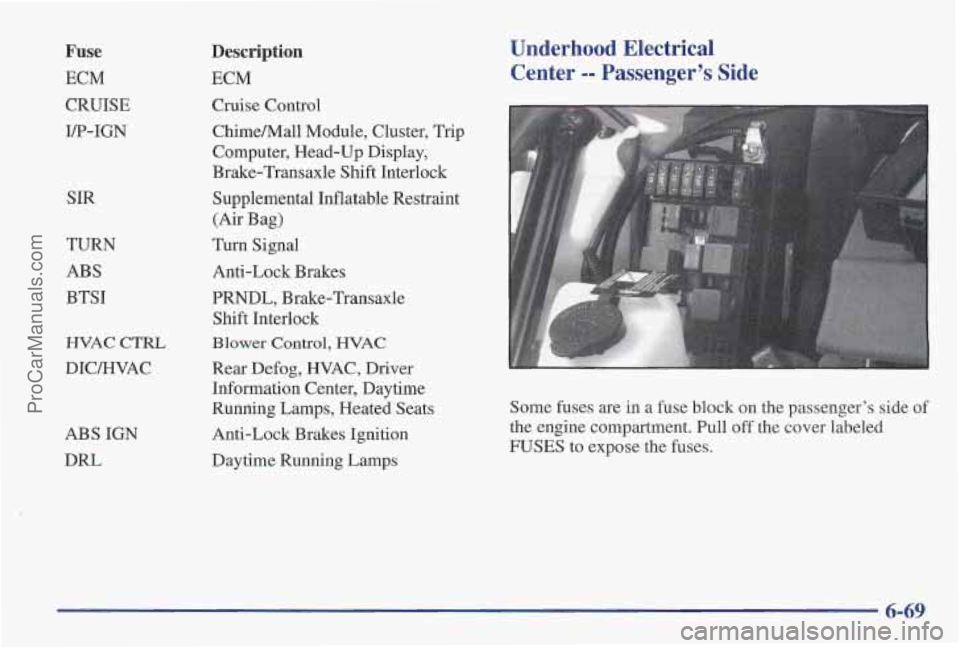
Fuse
ECM
CRUISE
I/P-IGN SIR
TURN
ABS
BTSI
HVAC CTRL
DIC/HVAC
AB’S IGN
DRL
Description
ECM
Cruise Control ChimeMall Module, Cluster, Trip
Computer, Head-Up Display,
Brake-Transaxle Shift Interlock
Supplemental Inflatable Restraint
(Air
Bag)
Turn Signal
Anti-Lock Brakes
PRNDL, Brake-Transaxle Shift Interlock
Blower Control, HVAC
Rear Defog, HVAC, Driver
Information Center, Daytime
Running Lamps, Heated Seats
Anti-Lock Brakes Ignition
Daytime Running Lamps
Underhood Electrical Center
-- Passenger’s Side
Some fuses are in a fuse block on the passenger’s side of
the engine compartment. Pull off the cover labeled
FUSES to expose the fuses.
6-69
ProCarManuals.com
Page 387 of 419
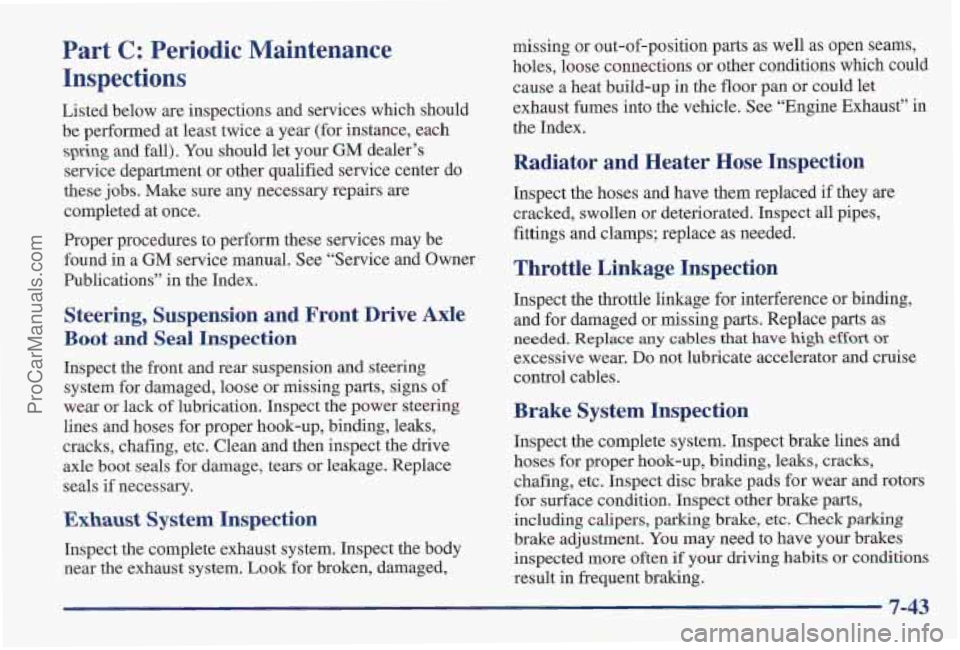
Part C: Periodic Maintenance
Inspections
Listed below are inspections and services which should
be performed at least twice a year (for instance, each
spring and fall). You should let your GM dealer’s
service department or other qualified service center do
these
jobs. Make sure any necessary repairs are
completed at once.
Proper procedures to perform these services may be
found
in a GM service manual. See “Service and Owner
Publications” in the Index.
Steering, Suspension and Front Drive Axle
Boot and Seal Inspection
Inspect the front and rear suspension and steering
system for damaged, loose or missing parts, signs of
wear or lack of lubrication. Inspect the power steering
lines and hoses for proper hook-up, binding, leaks,
cracks, chafing, etc. Clean and then inspect the drive
axle boot seals for damage, tears or leakage. Replace
seals if necessary.
Exhaust System Inspection
Inspect the complete exhaust system. Inspect the body
near the exhaust system. Look for broken, damaged, missing
or out-of-position parts as well
as open seams,
holes, loose connections or other conditions which could
cause a heat build-up in
the floor pan or could let
exhaust fumes into the vehicle. See “Engine Exhaust” in
the Index.
Radiator and Heater Hose Inspection
Inspect the hoses and have them replaced if they are
cracked, swollen or deteriorated. Inspect all pipes,
fittings and clamps; replace as needed.
Throttle Linkage Inspection
Inspect the throttle linkage for interference or binding,
and for damaged or missing parts. Replace parts as
needed. Replace any cables that have high eEort or
excessive wear. Do not lubricate accelerator and cruise
control cables.
Brake System Inspection
Inspect the complete system. Inspect brake lines and
hoses
for proper hook-up, binding, leaks, cracks,
chafing, etc. Inspect disc brake pads for wear and rotors
for surface condition. Inspect other brake parts,
including calipers, parking brake,
etc. Check parking
brake adjustment. You may need to have your brakes
inspected more often
if your driving habits or conditions
result in frequent braking.
ProCarManuals.com
Page 409 of 419
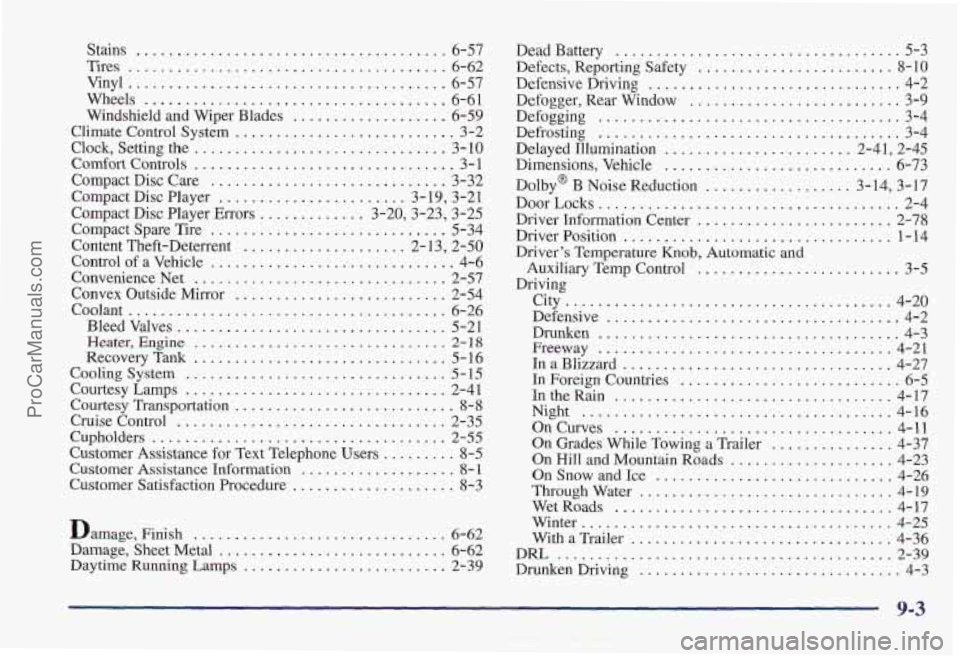
Stains ...................................... 6-57
Tires ....................................... 6-62
Wheels
..................................... 6-61
Vinyl
....................................... 6-57
Windshield
and Wiper Blades ................... 6-59
Climate Control System
........................... 3-2
Clock, Setting the
............................... 3- 10
Compact Disc Care ............................. 3-32
Compact Disc Player
....................... 3-19, 3-21
Compact Disc Player Errors
............. 3-20,3-23, 3-25
Compact Spare Tire
............................. 5-34
Content Theft-Deterrent
.................... 2- 13, 2-50
Control of a Vehicle
.............................. 4-6
Convenience Net
............................... 2-57
Convex Outside Mirror
.......................... 2-54
Coolant
....................................... 6-26
Bleed Valves
................................. 5-21
Heater.
Engine ............................... 2-18
Cooling System ................................ 5-15
Courtesy Lamps
................................ 2-41
Courtesy Transportation
........................... 8-8
Cruise Control ................................. 2-35
Customer Assistance for Text Telephone Users
......... 8-5
Customer Assistance Information ................... 8- 1
Customer Satisfaction Procedure .................. 8-3
Comfort
Controls
...... ..................... 3-1
RecoveryTank
............................... 5-16
Cupholders
.................................... 2-55
Damage. Finish
..................... .... 6-62
Damage. Sheet Metal ............................ 6-62
Daytime Running Lamps ......................... 2-39 Dead Battery
....... ..... 5-3
Defects. Reporting
Safety ... .............. 8-10
Defensive Driving ............................... 4-2
Defogger. Rear Window .......................... 3-9
Defogging ..................................... 3-4
Defrosting
..................................... 3-4
Delayed Illumination
....................... 2-41. 2-45
Dimensions. Vehicle
............................ 6-73
Dolby@ B Noise Reduction .................. 3-14. 3-17
Door Locks
..................................... 2-4
Driver Information Center
........................ 2-78
DriverPosition ................................. l-14
Driver’s Temperature Knob. Automatic and
Auxiliary Temp Control
............... ....... 3-5
Driving City
........................................ 4-20
Defensive
.................................... 4-2
Drunken ..................................... 4-3
Freeway
.................................... 4-21
InaBlizzard
................................. 4-27
...........
In Foreign Countries ........................... 6-5
In the Rain .................................. 4-17
On Curves
.................................. 4-11
On Grades While Towing
a Trailer ............... 4-37
On Hill and Mountain Roads
.................... 4-23
On Snow and Ice
............................. 4-26
Through Water
............................... 4-19
WetRoads .................................. 4-17
Winter
...................................... 4-25
With a Trailer ................................ 4-36
Drunken Driving
................................ 4-3
Night
...................................... 4-16
DRL ......................................... 2-39
9-3
ProCarManuals.com